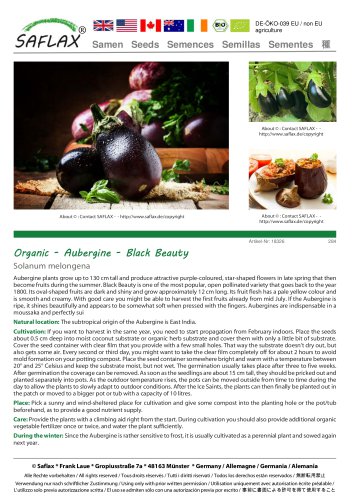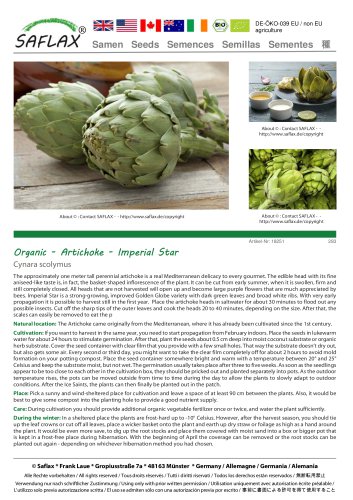
Catalog excerpts

Samen Seeds Semences Semillas Sementes 種 About © : Contact SAFLAX - http://www.saflax.de/copyright About © : Contact SAFLAX - - http://www.saflax.de/copyright About © : Contact SAFLAX - http://www.saflax.de/copyright Organic - Tomato - Berner Rose Solanum lycopersicum This traditional Swiss variety grows huge fruits with a characteristic pinkish colour. Due to its full flavour it is one of the most popular varieties with tomato fans. The plant can easily be recognized by its slightly blue colour. The rather late ripening juicy fruits are a little bit vulnerable to cracks due to the soft skin. Most popular are, of course, tomato sauces and tomato soups, but also the use of big tomato chunks in vegetable and meat stews. Strained tomatoes make an ideal pizza topping. Moreover, tomatoes are the basic ingredient for many pasta casseroles, like Lasa Natural location: Tomatoes originally came from South and Central America. Cultivation: You may start seed propagation in mid March at a bright and warm place indoors. Spread the flat seeds about 2 cm apart from each other onto moist coconut substrate or organic herb substrate and cover them only slightly with earth. Keep your potting compost moist, but not wet – preferably by using a water sprayer for moistening. Cover the seed container with clear film to prevent the earth from drying out. Don’t forget to make some holes in the clear film and take it every second or third day completely off for about 2 hours. That way you can avoid mold formation on your potting compost. Place the seed container somewhere bright and warm with a temperature between 20° and 24° Celsius. The first seedlings should come up after one or two weeks. Now, you can remove the cover and keep the sprouts in a somewhat cooler, but bright place without exposing them to the hot midday sun. As soon as the seedlings develop the second pair of leaves, you can prick out until the first pair of leaves, and plant the sprouts into small 10 cm pots with a bottom hole and filled with organic vegetable substrate. When they reach a height of approximately 10 cm, you need to support the plants with a small stick. In mid May and after the Ice Saints, the plants can be planted out at a sunny place in the garden with around 75 cm gaps between them, or you move them into tubs. Place: A sunny place that is sheltered from the rain and wind would be ideal for cultivation. Care: As the plants grow tall they will need strong supporting struts or tomato stakes. Water the plants evenly, but avoid water-logging. Pluck out the side-shoots between the stem and the base of the branches regularly. Since the rooting of the plants will develop strongly in the beginning, the visible sprouts grow rather slow initially. About 4 weeks and 8 weeks after planting out, you may provide the plant with some organic vegetable fertilizer. During the winter: Sow again the following year. Tomato plants belong to the nightshade family. Except for its ripe fruits all other parts of the plant are poisonous. © Saflax * Frank Laue * Gropiusstraße 7a * 48163 Münster * Germany / Allemagne / Germania / Alemania Alle Rechte vorbehalten / All rights reserved / Tous droits réservés / Tutti i diritti riservati / Todos los derechos están reservados / 無断転用禁止 Verwendung nur nach schriftlicher Zustimmung / Using only with prior written permission / Utilisation uniquement avec autorisation écrite préalable / L'utilizzo solo previa autorizzazione scritta / El uso se admiten sólo con una autorización previa p
Open the catalog to page 1All MSL GmbH & Co. KG catalogs and technical brochures
-
Organic - Wild Rocket
1 Pages
-
Levant Cotton
1 Pages
-
Indian Cedar
1 Pages
-
Chicory
1 Pages
-
Common Tobacco
1 Pages
-
Sunflower Titan
1 Pages
-
Organic - Squash - Delicata
1 Pages
-
Organic - Florence Fennel
1 Pages
-
Organic - Nettle
1 Pages
-
Organic - Coriander
1 Pages
-
Organic - Chives
1 Pages
-
Organic - Basil Genovese
1 Pages





























